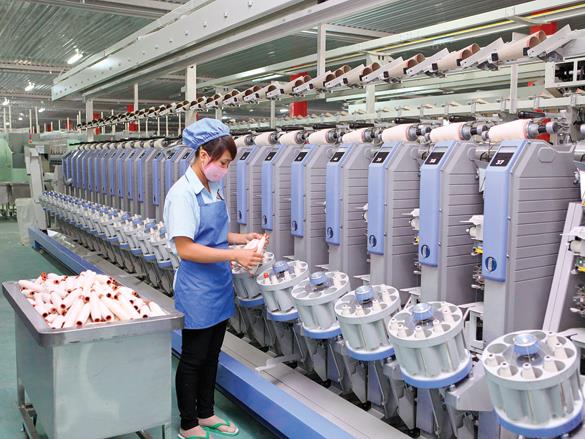Fibre industry on the rise

Vietnam’s export value of fibre amounted to an estimated $1.6 billion in the year to August, a 20 per cent rise on-year with major suppliers like Phong Phu, Tra Ly, Phu Bai, and Hoa Tho signing export contracts with foreign partners for the whole of this year.
After many years of reliance on material imports, the local garment industry has become much more independent, with the spinning sector making the gains needed to get there.
Among the leaders in the spinning business is Phong Phu Joint Stock Corporation, which operates three companies producing and trading in fibre and eight spinning factories providing a variety of quality fibres and threads.
“Phong Phu’s fibre products feature strong visibility in the domestic market, particularly in the high-end segments such as OE cotton or cotton ring fancy. Besides, our company is the main distributor of quality thread to UK-based Coats Group,” said the company’s general director Pham Xuan Trinh.
Phu Nam Fibre JSC, based in the Phu Bai Industrial Park in the central province of Thua Thien-Hue, has the capacity to supply nearly 30,000 spindles, half of which are sold in the domestic market.
The company envisages scaling up production to surpass 30,000 spindles to meet growing demands both at home and abroad.
With approximately VND500 billion ($23.8 million) in the total revenue last year, of which exports accounted for 40 per cent, Tra Ly Fibre JSC has made a significant contribution to fulfilling the demand of fabric producers.
Its new spinning factory, with 15,000 spindles and costing VND160 billion ($7.6 million) in the total investment capital, was commissioned in the second quarter this year.
Hanoi Textile Garment Joint Stock Corporation (Hanosimex) is a typical example when it comes to making investment into boosting fibre production capacity.
“Our VND410 billion ($19.5 million) project to invest in 36,000 spindles with the annual capacity of 6,400 tonnes of quality fibre was approved by parent company Vinatex and is slated to kick-off construction early next year,” said the company’s general director Nguyen Song Hai.
The Vietnam Cotton and Spinning Association (VCOSA) has forecasted that export surplus in the fibre industry could be in the range of $1-1.1 billion this year, compared to $600 million in the first eight months of this year.
VCOSA statistics show that by the end of 2013, Vietnam was home to more than 100 spinning businesses with 6.1 million spindles and total output of 720,000 tonnes. This represented around 2.1 per cent of global production capacity (250 million spindles).
Of the 720,000 tonnes, 250,000 tonnes is distributed domestically and 470,000 tonnes is earmarked for export.
Vietnam’s leading fibre export market is China, making up 44 per cent of total value, followed by South Korea, Indonesia, Thailand and India.
What the stars mean:
★ Poor ★ ★ Promising ★★★ Good ★★★★ Very good ★★★★★ Exceptional
Latest News
More News
- Mitsubishi Estate launches Logicross Hai Phong - a milestone in logistics evolution (November 20, 2024 | 14:32)
- Semiconductor workforce partnerships deliver industry-relevant training (November 20, 2024 | 10:58)
- German Quickpack to invest $31.7 million in Long An province (November 20, 2024 | 09:31)
- Foreign-invested enterprises drive logistics investment in the southeast region (November 20, 2024 | 09:27)
- Chile visit underscores trade benefits (November 19, 2024 | 10:00)
- Trump’s second term impacts sci-tech activities and industry 4.0 technologies (November 18, 2024 | 10:00)
- Vietnam eyes nuclear revival to bolster energy security (November 14, 2024 | 16:46)
- Kyokuyo completes $13.5 million seafood factory in Vietnam (November 14, 2024 | 12:19)
- VinFast receives $3.5 billion funding from Vingroup and Pham Nhat Vuong (November 14, 2024 | 06:38)
- Localities sprint to reach FDI targets (November 13, 2024 | 10:00)


















 Mobile Version
Mobile Version